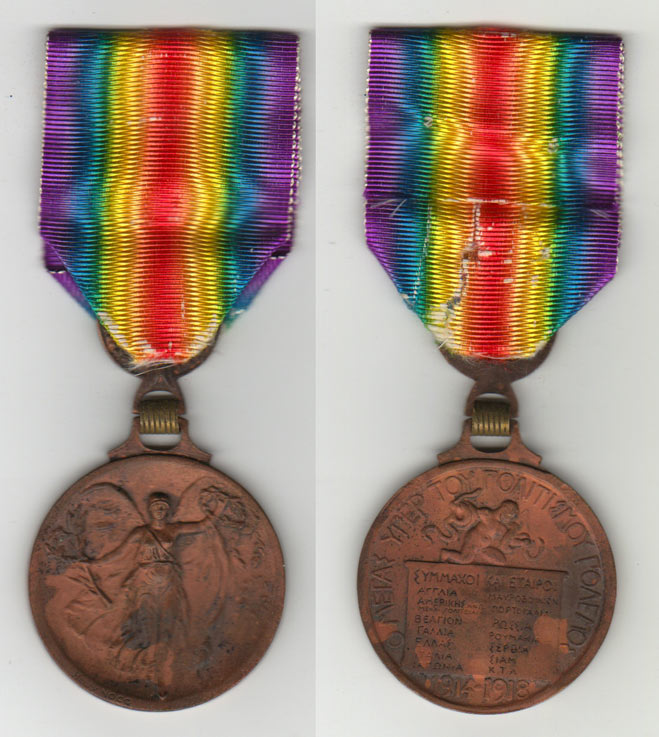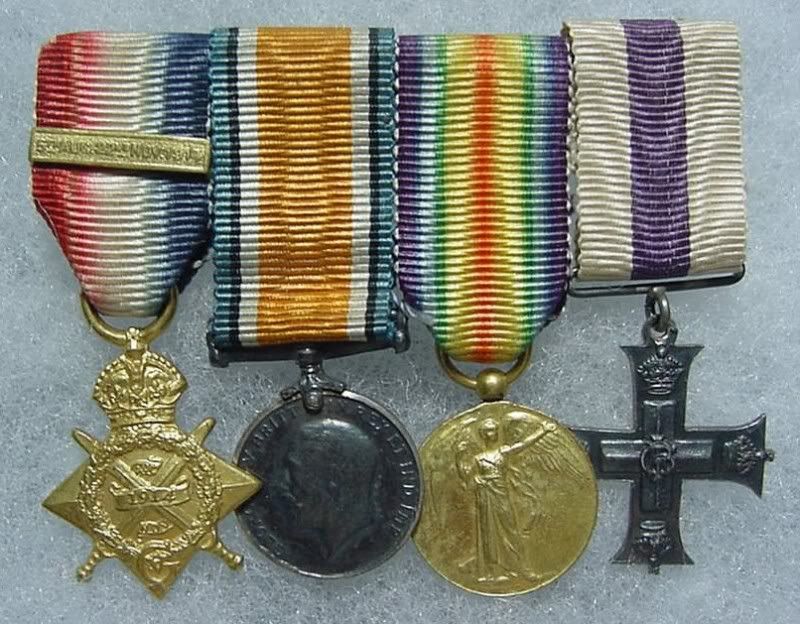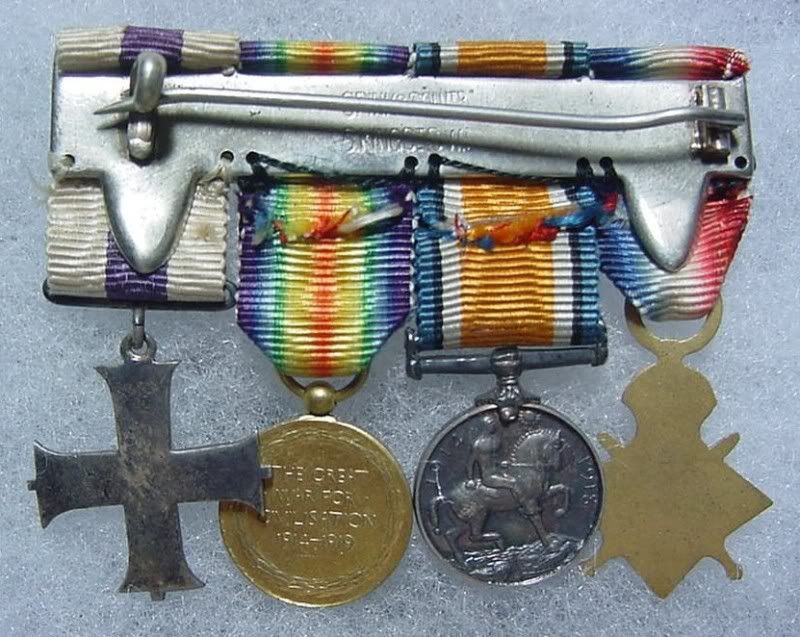-
Posts
1,219 -
Joined
-
Last visited
Content Type
Profiles
Forums
Blogs
Gallery
Events
Store
Posts posted by lambert
-
-
Very cool! The OMSA database has a link to the NY records (compiled by an OMSA member). You can confirm the mans' identity there.
Nope- spoke too soon. OMSA is selling a hard copy of the New York numbers (greedy people) but Jeff Floyd has the list. He's a good guy and if you ask him he'll probably help you out.
Hi Ulsterman
The numbering of the coin identifies each soldier who won? This seems very difficult to control.
lambert
0 -
This is a series that I also like very much, this example this superb.
The few I am assembling this collection, which also has some medals hard to find.
Rob, how many Service Medals do you have?
Regards
Lambert
0 -
The seller put back on sale.

with an attractive price.
http://www.ebay.co.u...4#ht_500wt_1287
:beer:
0 -
Hi Bill,
I do not, apparently, nothing wrong with the medal Type 1, the image doesn't help much but seems this Ok. The price also does not scare me, I've seen more expensive.
Lambert
0 -
This is my Example, with the Green cardboard box. with the manufacturer's Mark Victor Canale of Paris.

By RobW
Lambert
0 -
Hi Bill.
Johny is right. This is the Medal of the type 2 (official)
This is the information I know.
manufacturing variations.
Type 1 (official form) is named after the sculptor Henry NOCQ the edge of the obverse.
Type 2: As above, distinguished by different signature of the sculptor, HENRY NOCQ (name in capital letters), placed above the edge of the obverse.
Type 3: Details different, especially in the ring of the ribbon. This model does not contain the signature of the sculptor.
Type 4: Manufacture Huguenin. This model does not contain the signature of the sculptor.
Lambert
0 -
I am sure, can I include Welsh in the next message. : D
Hapusrwydd a Heddwch
Lambert
0 -
Yes ... interesting group. Both were officers, one in the 22nd French Canadian Battalion
Lambert Dumont Laviolette & Alexandre Laviolette

I would be very happy to find a group or even just a Medal with my name written.

Lambert
0 -
Hello Bill,
Really don't know. What I might notice is that the mount does not seem to have been modified. (It'll never know.)
I believe that it is the original 20. The black lines are very fragile believe that is ok.
As the order of the medals this wrong the first medal must be MC, followed by the 1914 Star. etc..
Lambert
0 -
I wish all friends of the forum, a very successful 2012.

Lambert :beer:
0 -
Hi.
A mini-group decoration of my collection
1914 Star
War Medal
Victory Medal
Militar Cross


lambert
0 -
Hi Bill,
Again the name of Mike Shank, haunts with its falsification.
I still don't have a Vic Siam, I am very careful in the search. This information is important for this acquisition. Thanks.
Regards
Lambert
0 -
Hi All
Today is 1 year that I am part of this Forum.
I am very grateful and I'm learning a lot with you all. Very grateful.
Lambert

 :lol:0
:lol:0 -
Hello John.
Yes now I understand better. Even with a setting almost correct, are false clasp. It became clear to me.
In 1985 I had 10 years of age. : D
Lambert
0 -
Resurrecting a very old topic ..
I have this mini group. with the Cross of Combatant Vichy. I found it very interesting.

 0
0 -
It may have been built later, but all seem to me claps from the same manufacturer?
"Claps" correct
11th Engineering:
- Cambrai
- Lys
- St. Mihiel
- Meuse - Argonne
- defensive Sector
other
- Somme offensive (17th, 148th Pursuit Squadron, 27th, 30th, 33rd Div.)
- Ypres-Lys (27th, 30th, 37th, 91th Div)
- Verdun (not official)
In the document itself shows only the claps of the Engineering Corps. others were added later ..
"the communication was numbered engrs.
in applying for you victory medal you are entitled to bars according as to wasther you served in any one of the above datas.
If you desire to have your discharge notice amended you may send it to the adjuntant general office, washington, with a statement showing what additional battle participations you are entitled to other those shown on your discharge notice, the Victory Medal regulations entitle the holders to one bar or star for each battle and one bar ou star for a defensive sector, regardless of the number of defensive sectors at which the holder participated."
Lambert
0 - Cambrai
-
Hi Gents,
I've just come across the on-line catalogue for the Watson Medal Collection in the Fitzwilliam Museum, in Cambridge. http://www.fitzmuseu...lection/watson/
This collection has been mentioned a couple of times on the GMIC Forum in the past. However, I found a section in the catalogue dealing specifically with the Inter-Allied vics - there are 13 in the collection, covering most of the Allied nations. They are here http://www.fitzmuseu...gue/index5.html just below section E (no, it isn't called F!).
The collection was amassed in the late 1920s, according to the catalogue notes. Of interest is the Great Britain vic, which the notes say is un-named, and seem to imply that none were named. The Japanese is correctly catalogued as a copy, and the Greek is the 'no-O' version. Does anyone have any other observations of the medals shown?
Just shows - we are following in a long tradition of Inter-Allied vic collectors.
Bill
Hi All
The Czech medal is a medal made in France in 1920, called "reproduction" I understand, isa very rare model of the manufacturing Czechoslovakia.
Lambert
0 -
Lambert,
If he is right now selling ebay can you post one of his items numbers?
Jim.
Yes.
He has an unofficial Italian type unmarked U $ 154.00

She seems to be ok. However, I do not dare buy it.
0 -
Hello If someone is looking for this type medal there is one on ebay for sale, starting $20. ending on Dec13, 2011 Jim
http://www.ebay.com/...984.m1423.l2649
He does not send to Brazil ...

Lambert
0 -
Michelju is well known for manufacturing fakes as well, like the Greek Bavarian Volunteers' medal and the Cross of Independence. Their quality is better than the originals. Of course, he never says that they are fakes and in every militaria show you can see that he has 1 or 2 for display. I was one of his victims, too, as I bought one of the first pieces that he sold and the collecting community was not aware of this fraud. Since then, many collectors have been deceived. The funny thing is that ebay does not care; even though I sent emails and protested about this issue, nothing was done.
This is true not only with this seller, but many others do not care if they sell fake or not.
Lambert
0 -
I understand that this seller shows pictures of the item but send items false..
Well, I never bought this guy ..
Lambert
0 -
Here, some of the Biography of the Author of Portuguese Medal.
João da Silva was born in Lisbon on 1 December 1880.
After attending the Industrial School Príncipe Real, in which he enrolled in 1893, he travelled to Paris where he studied at the School of Fine Arts. At this school, he received the first prizes in the subjects of Medals, Sculpture, Applied Art and Drawing, and in just two years he completed the Medal Course with the sculpture and medal maker Jules Chaplain (1839-1909). For his exam, he submitted a bronze plaque – "Les funérailles d’ Atala" -, executed in the workshops of the Mint of Paris.
After completing his artistic training, he worked as an engraver at the Fleuret House. In 1900, he submitted two pieces for the Universal Exhibition of Paris.
At the end of the following year, he moved to Geneva. In this city, he attended the Jeweller-Engraving course at the School of Fine Arts. To obtain a certificate, he produced a carved plate in silver - "A toilette de Diana"-, which now belongs to the Museum of Fine Arts of Geneva.
When he returned to Portugal, he resumed his activity as a sculptor, goldsmith and medal maker, and between 1911 and 1914 he taught Applied Art, Jewellery and Drawing at the Marquês de Pombal School.
He participated and was awarded many prizes in numerous exhibitions in Portugal and abroad. He received a 3rd place medal in the 5th Exhibition of the National Society of Fine Arts in 1905, and a second class medal at a show in that same institution in 1917. He won the 1st prize ex-aequo with René Lalique (1860-1945) in the Exhibition of Rio de Janeiro (1908), an honourable mention at the Paris Salon in 1908 and an honourable mention and gold medal at the Lisbon Salon in 1911.
Among his vast sculpture works, some are quite noteworthy: the Bust of the Republic, carved for the Constituent Assembly and inaugurated in the Parliament in 1911 (later, this bust disappeared), several monuments to the dead of the First World War (Évora – 1933 and Valença do Minho - 1951, for example), and the monument in memory of the children who died in the 1914-1918 war, produced one year after it ended and intended for the French municipality of Pouliguen.
João da Silva also produced the monuments in honour of Augusto Gil (1935) for the city of Guarda, and of the Baron of Rio Branco, for Rio de Janeiro, the "Fons Vitae" for the Luso Thermal Waters and the "Fonte da Juventude" for the Portuguese Pavilion in the Seville Exhibition in 1929. He was also the author of the silver epitaph dedicated to General Don José Henrique Varela Iglésias, in the cemetery of Toledo, the silver quill and inkstand offered to Afonso Costa, the "Floreira duas Pátrias" offered to the Brazilian President, Hermes da Fonseca, when he visited Portugal in 1912, and the sculpture representing the winner of the prize "A mais bela mulher de França" [The most beautiful woman in France], established by the French newspaper "Le Monde".
For the city of Porto he produced two emblematic works: the monument to Júlio Dinis, commissioned by the Faculty of Medicine in 1923 and inaugurated in 1926 (through public subscription), and the monument in memory of the students of the University of Porto who died in the 1914-1918 war, composed by a female figure covered with a veil and holding a palm leaf, is known as "The Saint" or "The Wisdom". Its inauguration took place on 16 October 1948 in the entrance hall of the building which houses the University of Porto, in Gomes Teixeira Square, dated 16 October 1948.
As a medal maker, João da Silva produced memorable works, such as the first gold coin of the Republic, in 1916, and the medal for the commemoration of the 1st centenary of the birth of Silva Porto, in 1950, commissioned by the Guild of Industrial Jewellers of the North of Portugal.
João da Silva was elected member of the National Academy of Fine Arts in 1933 and was distinguished with the "Soares dos Reis" Award by the National Secretariat of Information (SNI) in 1949, which he declined.
In 1952, he donated to the National Society of Fine Arts his house-workshop (now House-Museum Master João da Silva) built in 1938 by Ligier/Peige, following his guidelines.
He died in 1960 and was buried in Prazeres Cemetery, in Lisbon.
0 -
Lambert,
Great photo, but why is the obervse and the reverse suspension shown in your photo as being two different types for the same medal?
Jim M.
M Yes.
Only this photo.
I was wrong to say that it was "only" a few days .. I received this email in August 2011.
but only now remembered to comment on the matter .. I'm sorry.
The photo shows a Reverse Vic Portugal, already known (unsigned)
Obverse a Vic Portugal "Official" signed.
Two are unfortunately not sent another picture.
Lambert
0 -
Good morning Rob & JM
This news is really very interesting, and it changes our understanding of Vic Portugal. I think that after 91 years comes this new series on the MV.

Of course, there was probably never a great interest in researching the Vic in its own country (Portugal), among others.
Maybe then we will have more information about other medals (Brazil, Siam, Romania and Cuba), I think with little information.
Lambert
0



American (US) Victory Medals
in Inter-Allied Victory Medals of the Great War
Posted
Hello to all
Jim, great post!!
When your book comes out?
Lambert
:beer: